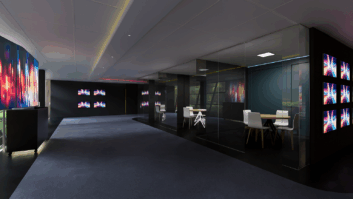If the 21st century has witnessed one consistent trend in office architecture, it’s the magnificent rise of the open-floor workspace. While an open environment fosters transparency and collaboration in the workplace, the constant action and noise can sometimes stunt productivity. If you’ve experienced this in your business, you might want to consider creating a huddle space.
The design of a huddle space can be customized to fit your specific business needs, but the general concept is that this room is a small shared space separated from the general population to allow fewer distractions and greater focus without giving up the cultural advantages of the open space plans for daily work.
A huddle space will often include monitors and wireless integration so that small groups can work on interactive presentations. They are also often soundproof.
In our fast-paced, extremely interactive business climate, a huddle space can add a lot to your business, including an increase in productivity, improved collaboration, and privacy.
US based IT solutions provider/advisor TFE gives its best three reasons for adding a huddle space in your office.
1. Productivity
Over 70 per cent of offices in the US have embraced an open concept plan. The only problem is that studies have also found we’re 15 per cent less productive. These statistics fall in line with what is known in some circles as “The Ringelmann Effect”, which is the tendency for individual members to become less productive as the size of a group increases.
The number-one reason why opponents dislike the open floor plan is the constant cacophony that comes with placing multiple people and departments in one large space.
Huddle rooms function in business the same way that “reading rooms” work in university libraries. You can use the space for a small workgroup, or for individual employees to cordon themselves off for mental marathons and power hours.
2. Remote Work via Video Conferencing
As many workforces become increasingly more mobile, superior video conferencing is becoming a huge priority for businesses. In one study, 66 per cent of chief experience officers (CXOs) consider mobile extensions of commonly used enterprise communications applications –including video conferencing–to be critical for their daily operations.
While one video conference system in the big conference room might have done the trick in previous years, an uptake in remote workers, paired with the glorious capabilities of VoIP to provide quicker video conferencing in higher resolution, has created a need for multiple, smaller conference spaces. A recent report found that there are over 50 million huddle rooms globally.
3. Safe Zones
One of the greatest benefits of a huddle space is that it provides a physical platform for expression of ideas in a more intimate setting. Some workers are not comfortable expressing themselves in an open environment, but will flourish in smaller groups.
A huddle space is perfect for small presentations, brainstorm sessions, and for conversations with a more limited audience.
Huddle Up
Creating the perfect workspace is all about balance. To counterbalance the limitations to creativity and cooperation in the traditional office space, open floor plans have been embraced to improve culture and collaboration. Now, businesses are adding back some of the much needed privacy of the traditional setting.
When you create your huddle space, make sure that it acts as a springboard for your employees to grow in their jobs and their teams. This will help your company grow as well.
This article was originally posted on by Texas based IT solutions provider/advisor TFE. The article in its original form can be viewed here.







